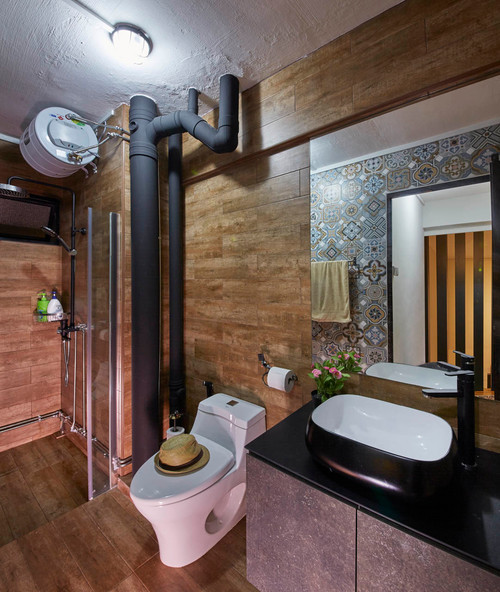Plumbing a house requires careful planning with a plan for plumbing. The plumbing system is summed up in three parts: the water supply system, drainage system of sewage, and ventilation system.

Photo by Carpenters.com.sg – More bathroom ideas
Let’s see first the basics of proper plumbing vent piping. Vent pipes are needed to supply air to water pipes.
The errors in installation can cause trap siphonage, odors and noises. We have to know that, without a network of vents feeding the drainage system in air, the flow of waste water would be almost impossible.
Some cities have a two drain pipes: a system for storm water drainage of rain, and a health system for the disposal of domestic waste water. Other cities have only one. The system will be connected to the plumbing in the basement. Many houses far from urban centers don’t have a drainage system and a septic field is required.
To resume, the plumbing vent system is part of the building plumbing drain system and serves two basic functions:
– 1. Allow building drains to flow freely outside the building by allowing air into the drain system, avoiding the vacuum and the slow drainage. Let’s see what happens in drain piping? If the system is properly designed, there is air in system before we flush the toilet or the water is poured down on drain. The water displaces the air pushing it down the drain in front of the rushing water. This air needs to be replaced so a vacuum doesn’t form in the system.
– 2. Allow sewer gases to be vented safely outdoors. Good plumbing vent system carries all the sewer gases outside (usually above the building roof) the building and it doesn’t allow these sewer gases flow back into the building drain pipes.
The breakdown of a plumbing system releases the gas outside, balance the air pressure in the pipes and prevents water retention in the trap of being sucked. The main pipe is the stack, and this column rises above the roof. There are two stack pipes:
– the soil stack pipe – carries waste from toilets to the house trap and connects the sewer line outside the building in a private septic system or on to public sewer system.
–the waste stack pipe – carries drainage away from sinks, tubs and showers.
Now, it is very important that, a plumbing fixture not to be too far from the vertical vent piping. If it is, the fixture doesn’t drain properly, producing slow drainage or gurgling noises. The poor drainage will lose the water from the plumbing trap allowing the sewer gases get into the building.
The distance allowed between a plumbing fixture (actually the fixture plumbing trap) and the vertical vent piping varies between a minimum and maximum as a function of the pipe diameter. Usually a pipe that’s 1.5 inches in diameter is sufficient to vent any residential fixture, but it depends how many fixtures you want to vent. However if the pipe is unobstructed the air can pass through and to be sure, the best is to extend a vent pipe from every fixture.
Tip: To prevent traps in downstream fixtures from being sucked dry, it is a good idea to install a vent pipe, usually within 3 feet, close to the fixture trap. This vent pipe will rise vertically towards the roof where it opens to the atmosphere to get the needed replacement air.
Usually the main vent pipe in the building is 4 inches in diameter and stays this size all the way through the roof. Above the roof is good to have a 6 inches pipe. It is a good idea if you live in an area with cold winters. The pipe will not get choked off with frost buildup.
Bending Copper Pipes with or without Tools (howtobuildahouseblog.com)


